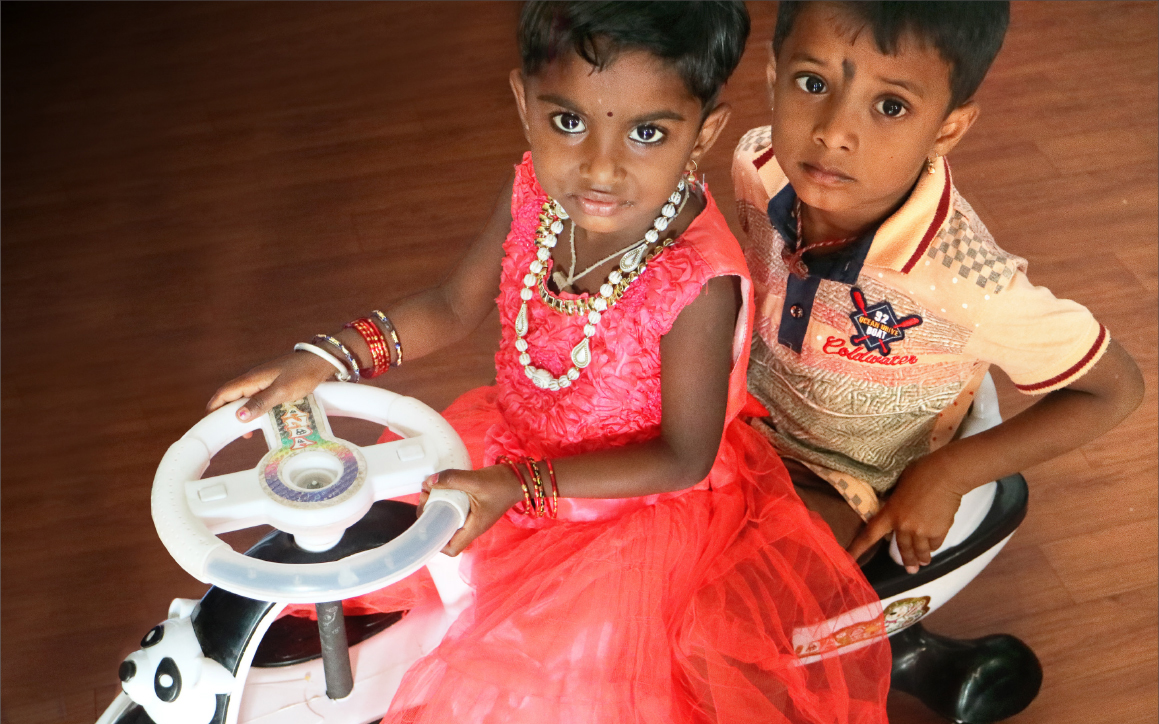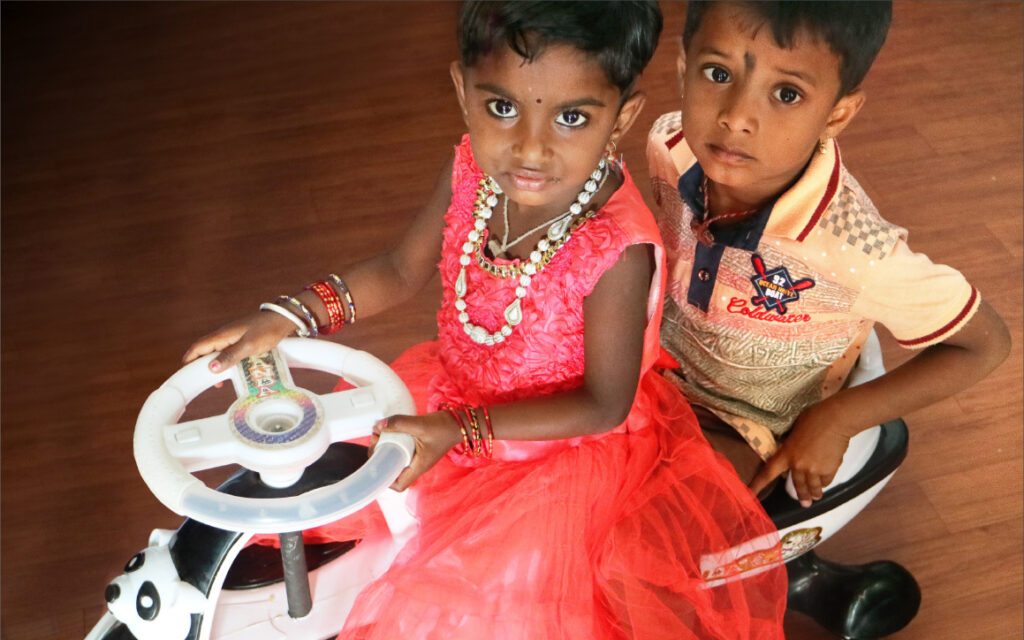
After a bumpy, 90-minute ride through the Kabini Reserve forest, 60 km from Mysore, we reach Brahmagiri Haddi, a remote Kurumba tribe settlement. Amidst the thatched roofs and makeshift huts stands the village’s reconstructed anganwadi, a neatly painted concrete building overlooking a coconut farm. Peep over its compound wall and you can see children running in circles, playing games and laughing.
The cheering gets louder as the Rotarians of Rotary Club of Mysore Midtown, RID 3181, enter the compound. High-fives are exchanged between the Rotarians and the children, and the adults seem to know each child by name. Oblivious to who is stepping in or walking out of his classroom, three-year-old Nanda is enjoying his hot glass of milk. He drinks up to the last drop, looks up at the Rotarians and in a cheerful tone says “Good morning.”
Where children are involved, the emotional appeal and mental satisfaction are indescribable.
– DG P Rohinath
Barely six months ago, this anganwadi was empty, desolate and in a state of disrepair. “The ceiling leaked and threatened to come crashing down, the water connection had been cut off, doors had been eaten by termites, and chipped floor and walls were covered with fungus,” says anganwadi worker, or the Accredited Social Health Worker (ASHA) Lakshmi. Today, thanks to a collaboration between the Department of Women and Child Development, Government of Karnataka, and District 3181, 517 such anganwadis have been transformed at a whopping cost of Rs 98.02 lakh in four revenue districts of this southern State. There is running water in the kitchen and toilet, the rooms are freshly painted and clean. Each anganwadi serves around 20 children, but with the makeover and provision of water, more children are seeking admission.

Titled ASHA Spoorthi, this District project is the brainchild of DG P Rohinath, and it hopes to provide adequate infrastructure, ensure school readiness and engage with the community to get good attendance from the children. DG Rohinath says all the 78 clubs are focused on this project. “This project concentrates on five of the six Rotary areas of focus. The clubs need to work on a sustainable project that falls within a focus area and this one allows them to concentrate on more than one. Where children are involved, the emotional appeal and mental satisfaction are indescribable. Hence 3,300 Rotarians from 78 clubs have come together for this initiative.”

Most parents who send their children to anganwadis are either daily wage workers, with most of the mothers working as maids, and have no safe place to leave their children. Rohinath says that when he visited an anganwadi in Mangaluru in 2009, its condition was so pathetic that he was in tears and decided that as a Rotary leader he would take up a big service project connected to anganwadis. Ten years later came the opportunity when he became a DG and this project took shape, in partnership with the Karnataka government. His club set up the first model anganwadi at Boccapatna, Mangaluru at a cost of Rs 6 lakh.
The villagers think Rotary has an answer to all their problems — a solution for the growing mosquito menace, a bus stop, a house — we can try.
– Project Chairman, H M Harish
He complimented Project Chairman HM Harish from RC Mysore South, for doing “a great job. He calls the clubs every week to check if the club has delivered its promise. He visits at least 30 centres per week to check the working of the project.” Coordinating with all the 78 clubs is not an easy task but Harish has learned the art to do it well. “You can have a fancy post in Rotary, but Rotarians will only do your bidding when you are soft-spoken and use the magic word ‘Please!’”

Explaining how the clubs get involved in such projects, he says, “they start by providing uniforms and shoes, basic furniture, stainless steel containers and plates, and then want to do more. Some clubs have converted a few anganwadis into state-of-the-art centres. Other clubs want to do more but lack the funds. The aim is to make the anganwadis in the district cleaner and more hygienic with an interesting atmosphere for the holistic development of the children.”
Rohinath says self-sufficient clubs such as RC Vittla, which has 29 members, have adopted 29 anganwadis. “Every Rotarian in the club is working with an anganwadi. This inspired a local publication to adopt an anganwadi and renovate it. This is the power of doing good.” Rotarians of RC Mysore Heritage have constructed a two-storied building that houses 80 children.
Every Rotarian in the club is working with an anganwadi. This inspired a local publication to adopt and renovate one.
Stressing the importance of partnerships, the DG says the Brahmagiri Haddi anganwadi is supported by the Swami Vivekananda Youth Movement, a non-profit from Mysore. Not only do they engage in the anganwadi activities but help in developing local, innovative and cost-effective solutions to sustain community-driven progress.”
The clubs get access to anganwadi database, funding, and other information from NGOs and CSR partners.

For example, RC Mysore South East has partnered with L&T to set up the Kukkarahalli anganwadi. The infrastructure is as good as a private creche and children are taught reading, writing, math and English. “We give them picture books to inculcate in them a habit of reading and host meetings every month for mothers who are educated on nutrition, and other important healthcare information for their children, says Kalavathi, an anganwadi teacher.
At the Challahalli anganwadi, 35 km from Mysore, reconstructed by the same club, I find bright and cheerful children playing with toys and patiently awaiting their turn on the swing. The centre has a water purifier, convertible beds and a child-friendly toilet It was strange to see that the facility had no wash station. Club President Vishwanath explains that after the first wash station “was stolen, we have made one of brick and cement. Now it can’t be stolen!”

The Mathru Poorna scheme was launched in October 2017 as part of “the Karnataka government’s initiatives to fight hunger and malnutrition. Meant to meet the nutritional needs of pregnant and lactating women in rural areas, this scheme runs inside the anganwadi campus. Each of the 517 renovated anganwadis provide one meal a day for about eight mothers. Kavitha, a lactating mother, thanks Rotary for the working anganwadi at her village in Challahalli. “I had to walk close to seven km to the next village which has an anganwadi in order to get my meal. Shuttling between villages was exhausting. Now, with this anganwadi reconstructed, I don’t have to walk that far,” she says.
Also, when she became pregnant, the anganwadi teacher “gave me the right information on the right type of food and nutrition I should take in order to deliver a healthy child,” she adds.

When the Rotarians of RC Kollegal Midtown wanted to casually show the DG around the Hondarabalu anganwadi at a village 20 km from Mysore, the villagers came together to thank Rotary. But they wanted more! They requested the Rotarians to build a bus stop, renovate an anganwadi in another village, build for them concrete houses and find a solution to the growing mosquito menace. Smiled Harish: “They think Rotary has an answer to all their problems and “we can try. But right now, our focus is on developing anganwadis.”
At Karinanjanapura village, an emotional anganwadi teacher Sharadha said, “from feeling helpless that we could not do anything about the non-functioning anganwadi to now feeding and teaching 60 children, we cannot thank the Rotarians of RC Chamarajanagar enough, for the work you have done. Because of you these children will eat well and have healthier lives.”
Pictures by Kiran Zehra






